The Perfect Circle
For this task, we were split into groups with different colour pens in which we had to create a perfect looking circle with 60 seconds per person until reaching the end of the page. The aim was to see eachothers approach as apposed to the medium (which in this case worked for each exercise we did) and to analyse the process. I believe this task is a good way to interact.
Hatching
This being one of my favourite out of the four conditional design workshops, was also a group effort in which players took turns in placing dots within 10cms from eachother in order to create a straight line. The duration of the activity was 5 minutes therefore having to do as much as we could quickly before the time ended. The way in which this works is to use the materials logically or in a way which influences and activates the process and direction in which you choose to take.
The Beach
I particulary liked this task as it was quick but also needed deep concentration the more full the page gets. In our groups we all used our individual colours and place a dot one after the other, it was interesting to see the direction in which everyone took and the positions on the page that people laned more towards.
FluxFold
Fluxfold was my least favourite out of the for, myself and my group didnt quite understand terefore ended up creatig our own verion, as for the cocept behind it and the turn out, the task was a good demonstration of what conditional design is about.
ARDUINO
HOME PAGE
CONDITIONAL
DESIGN
LIBRE GRAPHICS
DATA GATHERING & DISPLAY REMIX
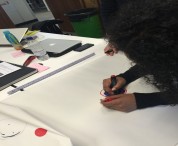
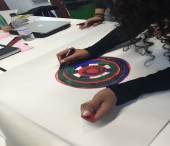
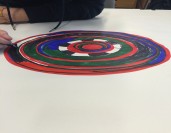
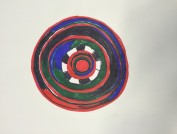
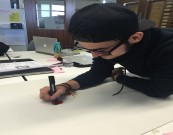
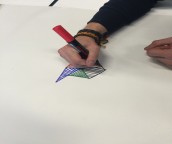
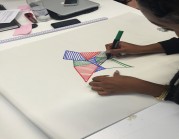
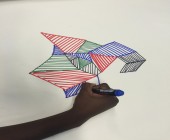
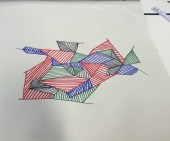
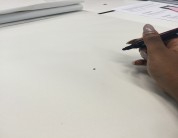
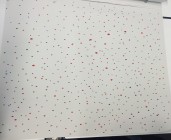
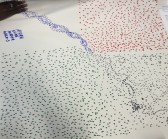
Through the influence of the media and technology on our world, our lives
are increasingly characterized by speed and constant change. We live in
a dynamic, data-driven society that is continually sparking new forms of
human interaction and social contexts. Instead of romanticizing the past,
we want to adapt our way of working to coincide with these developments,
and we want our work to reflect the here and now. We want to embrace the complexity of this landscape, deliver insight into it and show both its beauty and its shortcomings.
Our work focuses on processes rather than products: things that adapt to
their environment, emphasize change and show difference.
Instead of operating under the terms of Graphic Design, Interaction Design,
Media Art or Sound Design, we want to introduce Conditional Design as a
term that refers to our approach rather than our chosen media. We conduct
our activities using the methods of philosophers, engineers, inventors and
mystics.
The process is the product.
The most important aspects of a process are time, relationship and change.
The process produces formations rather than forms.
We search for unexpected but correlative, emergent patterns.
Even though a process has the appearance of objectivity, we realize the fact
that it stems from subjective intentions.
Logic is our tool.
Logic is our method for accentuating the ungraspable.
A clear and logical setting emphasizes that which does
not seem to fit within it.
We use logic to design the conditions through which the
processcan take place.
Design conditions using intelligible rules.
Avoid arbitrary randomness.
Difference should have a reason.
Use rules as constraints.
Constraints sharpen the perspective on the process and
stimulate play within the limitations.
The input is our material.
Input engages logic and activates and influences the process.
Input should come from our external and complex environment: nature,
society and its human interactions.
MANIFESTO BY MONIKER
PROCESS
LOGIC
INPUT
The Perfect Circle Rules
End each turn with a perfect circle which is larger than the previous one.
Each person must take 60 seconds to take their turn.
Finish when you reach the end of the page.
Hatching Rules
Draw a straight line
The line must connect two dots.
The angle of the line must be within the following range: 0 to 45 degrees for the black lines, 45 to 90 degrees for the blue lines, 90 to 135 degrees for the red lines, 135 to 180 degrees for the green lines.
Connect the line to an existing line if possible.
Draw the shortest possible line from your starting point. If you enclose an area (a plane surrounded
by lines) then hatch it with lines parallel to the line you enclosed the area with. The enclosed area
may not contain unconnected dots or open ended lines.
Place a Dot
The position of the dot is not further away than 10 cm from other dots and not inside the
convex hull of all dots.
The Beach Rules
Each turn, find the most empty space on the paper and place a dot in
the middle of it. Do this as quickly as you can in 5 minutes.
FluxFold
Tasks Performed the First Turn by Each Participant
Lift your corner of the paper from the table and bring it to any place on the paper so that one other
corner must be lifted too.
While keeping the corner at its position, press the paper
flat and make a fold.
Unfold the paper again to its standard position.
Place a dot somewhere on your fold.
Tasks Performed All Following Turns by Each Participant
Folding the paper
Bring your corner of the paper to the end of the line drawn by the participant on your right.
If that participant has only placed a dot, bring your corner to that dot.
While keeping the corner at its position, press the paper flat and make a fold.
Unfold the paper again to its standard position.
If the fold is almost parallel to the edge of the paper, place some small dots at the ends of the fold, so to clearly mark it as your fold.
Draw a straight line
Start your line at the end of your last drawn line.
Your line should always follow a fold.
Your line may cross other lines but it may not be on top of other lines.
The end of your line should always be where one of your own folds crosses a fold by someone else.
THE WORKSHOP
FINAL PROJECT